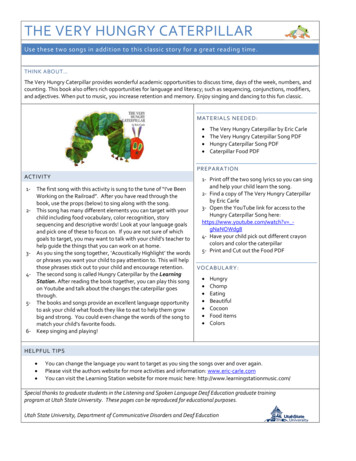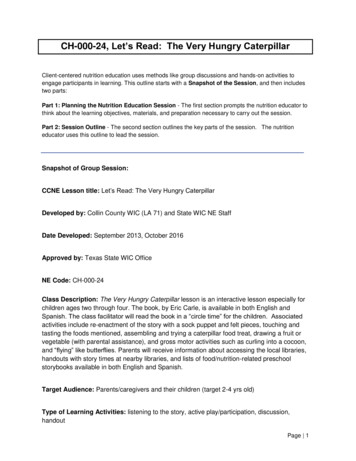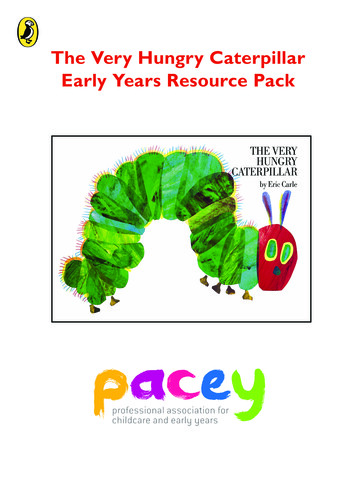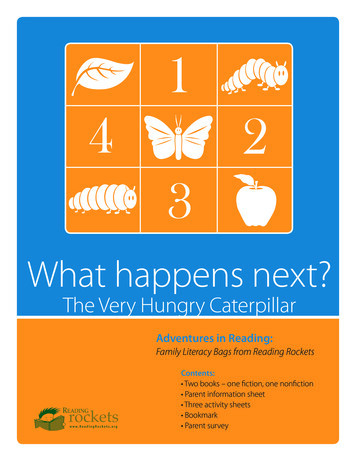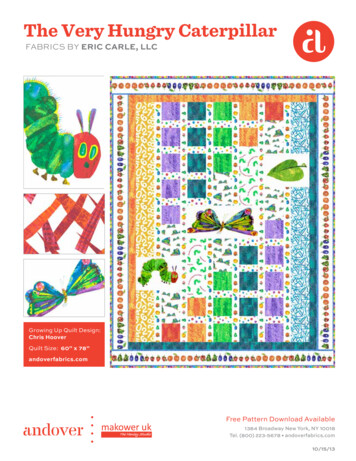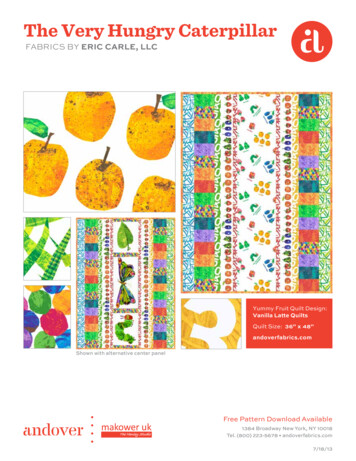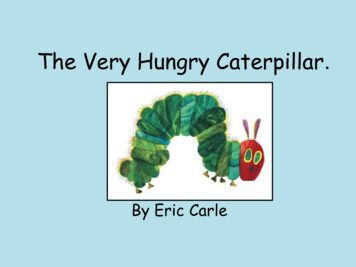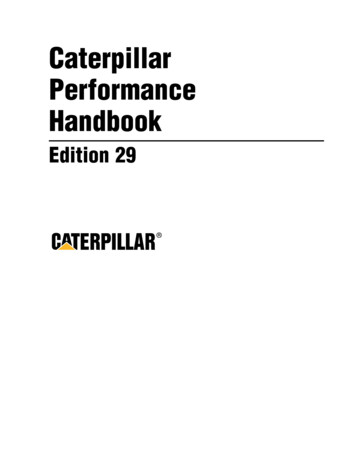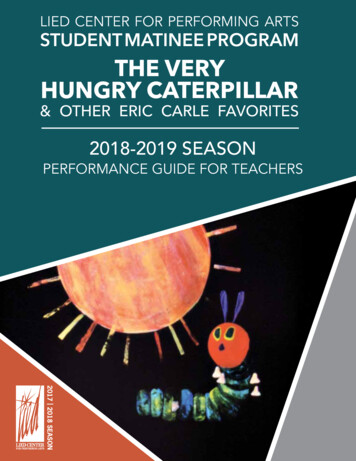
Transcription
LIED CENTER FOR PERFORMING ARTSSTUDENT MATINEE PROGRAMTHE VERYHUNGRY CATERPILLAR& OTHER ERIC CARLE FAVORITES2018-2019 SEASONPERFORMANCE GUIDE FOR TEACHERS
BACKGROUNDSpecial performances of world-class artists bring young people and educators (Pre-K-12th grades) together from acrossNebraska to share an unforgettable experience. Presenting all genres of performing arts – theater, music and dance –the Lied’s student matinee performances enhance classroom learning, expand cultural awareness and inspire youngpeople and their teachers through exposure to the arts.ABOUT THE VERY HUNGRY CATERPILLAR ANDOTHER ERIC CARLE FAVORITES PERFORMANCESMermaid Theatre of Nova Scotia’s elegant stage adaptation of Eric Carle’s beloved work has made theatre history, bothin Nova Scotia and throughout North America. The performance is designed to introduce young audience members totheir first performing arts experience as well as to encourage literacy and the love of reading. The Very Hungry Caterpillarand Other Eric Carle Favorites includes the story of The Very Hungry Caterpillar’s metamorphosis into a beautifulbutterfly; the fanciful account of Little Cloud’s travels through the sky; and The Mixed-Up Chameleon’s discovery ofhis own unique nature. By following the Carle’s books closely, the performance provides a seamless entry into the worldof theatre and music for these students. The performance’s use of innovative black light staging techniques highlightsJim Morrow’s stunning puppets and props. To see the promotional video of the show, visit http://www.youtube.com/watch?v PrZh6UOPVSc.
THE MERMAID THEATRE OF NOVA SCOTIAMermaid Theatre of Nova Scotia was foundedin Wolfville in March 1972 by Evelyn Garbary,Sara Lee Lewis and Tom Miller. Despite theirdifferent backgrounds, these three individualsshared a commitment to introducing familiesto the excitement of the performing arts andthe magic of literature. Based in Canada formore than 36 years, this theatre has becomeone of North America’s most respectedcreators of family entertainment, with TheVery Hungry Caterpillar and other Eric CarleFavorites becoming its signature piece. Thistheatre company takes a plethora of belovedchildren’s literature and adapts these storiesto the stage, such as Swimmy, Frederick andInch by Inch by Leo Lionni and GoodnightMoon and The Runaway Bunny by MargaretWise Brown and Clement Hurd. Not onlyhas the Mermaid Theatre of Nova Scotiabeen praised by its audience members, but ithas also received awards such as the ExportExcellence Awards from Nova Scotia and theGovernment of Canada.The Mermaid Theatre of Nova Scotiahas dedicated its work to both touringprofessionally with original performancesfor family audiences around the world andfocusing on their local community throughthe Youtheatre program, Institute of puppetryArts, and Mermaid Theatre Loft Programs.Hoping to improve children’s emotional andaesthetic development, this theatre companyoffers early exposure to literature, arts,and imagination through an entertaining,informative, and stimulating show.
THE ART OF PUPPETRYThe art of puppetry has charmed audiencesfor centuries. Even from the beginningof time, people have been using puppetsto represent what they are discussing.Primitive people would use rocks or twigsto represent the animals they were aboutto hunt. This continued through the yearsto finally create the art of puppetry forperformance. Since then, a variety ofpuppetry styles have come to be.Four major types of puppets are used inperformances by Mermaid Theatre ofNova Scotia. The Very Hungry Caterpillarand Other Eric Carle Favorites uses acombination of these types of puppetry.Marionettes, the first style of puppets,are wooden figures that are moved withstrings and gravity. They can be used ina number of settings from large theatersto children’s stories. The second type ofpuppets is hand puppets, which coverthe hand and forearm and are made ofsimple items. Hand puppets are the mostcommon because they are so versatileand simple to make. Rod puppets arethe third type of puppets to be used inperformances. They are usually bigger andhave more lifelike movements becausethey are controlled by rods, which allowthem to make bigger gestures. The finaltype of puppets are hand puppets thatuse rods to make gestures that are moreeffective for the main stage. Finally, thereare shadow puppets. These usually comefrom the East and create silhouettes.The Very Hungry Caterpillar and Other Eric Carle Favorites’ black light puppets cause it to stand out from otherperformances, just as Eric Carle’s unique tissue paper illustrations make his children’s books unique. The MermaidTheatre of Nova Scotia strives to have performances with striking visuals, and puppetry remains their central focus. Withtheir strong dedication to puppetry, the theatre company works to develop more interest in the art form throughoutCanada by conducting workshops. They also offer a number of internships and apprenticeship trainings for bothpuppetry and puppet production.
AUTHOR: ERIC CARLEEric Carle stands apart from his fellowchildren’s literature authors with hiscollage artwork often made fromlayering tissue paper. With more than70 children’s books authored anddesigned, Carle has gained attentioninternationally. While he has earnedmuch success in his adult life, Carle saidhe believes that a person’s upbringing,education, etc. are what inspire hisbeloved work. Carle was born inSyracuse, New York, but he spent mostof his childhood in Germany after heand his family moved there when hewas only six years old. Even though hedisliked the strict German school, Carledid not return to the United Statesfor seventeen years. While living inGermany, he would spend time walkingthrough the woods with his father.He also studied fine art at Stuttgartin Germany and became a graphicdesigner for the New York Times whenhe returned to the States in 1952. Healso eventually spent time as an artdirector for an international advertisingagency. He is best-known for hischildren’s books, which have sold morethan 25 million copies worldwide.All of his experiences growing up haveacted as inspiration for his books. Hedrew inspiration from his difficultiesin Germany as well as the nature thatfilled his afternoon walks with his father.Sometimes, his inspiration has come from his everyday experiences that would seem mundane or from nothing inparticular, such as a worm. When writing The Very Hungry Caterpillar, Carle had originally thought of a bookwormnamed Willy. When his editor asked, however, what he thought about the book using a caterpillar, instead one ofCarle’s most famous books came to be. It is Eric Carle’s unique tissue paper illustrations that make his children’sbooks unique.
STORIES THAT INSPIRED THE PLAYWhile many have read the beloved stories of Eric Carle, itmay help to have a synopsis of the three stories featured in theperformance to aid in preparation for the performance of postshow activities. See the Curriculum Connections portion ofthis performance guide to help you with some lesson plan ideasthat will tie the arts to your specific content area while relatingback to the play.THE VERY HUNGRY CATERPILLAROne of Carle’s best-known stories, The Very Hungry Caterpillarfollows the transformation of a caterpillar into a butterfly.In the book, the caterpillar travels through the pages, eatingholes through any food he can find. The caterpillar countshis way through food, such as apples, bananas and moreuntil he wraps himself up in his chrysalis. Children readingthe book watch the caterpillar grow with each item he eatsand see his metamorphosis into a butterfly by the end of thebook. Children learn more about a caterpillar’s life cycle, thedays of the week, and counting as they explore the belovedchildren’s book that inspired this performance.LITTLE CLOUDThe story of Little Cloud will appeal to all kids whohave spent hours watching clouds shift shape in thesummer sky. Little Cloud opens with a small cloudfloating through the sky alone while the bigger cloudstravel together. Little Cloud floats low, grazing thehouses he passes and continually grows and takes onthe shapes of everything that he loves to watch on theEarth below him. He morphs into a rabbit, shark, andmuch more as he makes his way back to the largerclouds that moves. After a full day of shape-shifting,Little Cloud joins the rest of his cloud friends, wherehe morphs together with the other individual clouds.Together, the clouds form a rain cloud and rain downon the Earth, helping to serve their role in the life cycleof the Earth that Little Cloud imitated on his journey.
THE MIXED-UP CHAMELEONThe story of the Mixed-Up Chameleon teaches children to accept themselves for who they are. The story openswith a green chameleon that lives an ordinary life of a chameleon: changing colors to match its surroundings.One day, the chameleon stumbles upon a zoo and is enamored by the variety of animals that fill its walls. As hewanders from exhibit to exhibit, he begins to yearn to be like the other animals. He wishes to be big and whitelike a polar bear, smart as a fox, handsome as a flamingo, and so on. When he wishes for these characteristics ofthe other animals, his wishes come true and he begins adopting the physical appearances of the animals he sowishes to be. After he is a culmination of all of these animals, a fly buzzes by his face, making him realize howhungry he is. Because he is no longer a chameleon, he does not have his long, sticky tongue to catch the fly. Realizing that he likes himself the way he was made, the Mixed-Up Chameleon’s wish to be a chameleon again comestrue. The story of the Mixed-Up Chameleon teaches students that everyone is unique for a reason and that thosedifferences should be celebrated.
POSSIBLE FOLLOW UP LESSONSTo ensure that students receive a truly arts integrated learning experience, it may help to continue using the arts to providea number of follow up activities after attending The Very Hungry Caterpillar and Other Eric Carle Favorites. The KennedyCenter for Performing Arts offers a number of interdisciplinary lessons that may be helpful following the performance. Withinthese lessons, many opportunities exist to promote literacy with your students. Below are a few examples of such lessons:THE DANCE OF THE BUTTERFLYCan you express the life cycle of the monarch butterfly through dance? This lesson falls perfectly in line with TheVery Hungry Caterpillar, and it may also be possible to use this lesson as preparation for the performance. Incorporatingscience, dance, and art, this lesson teaches students the stages of the life cycle of a monarch butterfly. It invites studentsto read Carle’s book, The Very Hungry Caterpillar, and draw pictures based on the images in the book. Students willthen examine photographs of the stages of a butterfly’s life cycle before creating a graphic organizer that describes thosestages. The lesson concludes with the students creating, choreographing, and performing a dance that represents thelife stages they have just studied. Encourage your students to engage with the written text to explore more languagearts opportunities within this science-rich lesson. Because this lesson is geared toward a younger grade level, it may behelpful to have them practice reading aloud portions of the book to ensure they become more literate in both readingand science concepts. One way to promote such reading aloud would be to have students partner up, sharing a copyof the book between them, and then whenever you stop, they must all read the following word aloud as a class. Bypausing on the words that enhance your lesson’s objectives, you will be reinforcing the content as well as promotingmore literacy as students must follow along with the reading. To view this entire lesson, visit s/grade-k-2/Butterfly Dance.aspx.ANIMAL HABITATSExplore animal habitats through story, song, drama, andart. Students will not only be introduced to the life cycle ofa butterfly in The Very Hungry Caterpillar, but they will alsobe introduced to various animals’ environments throughthe Mermaid Theatre of Nova Scotia’s rendition of Carle’sThe Mixed-Up Chameleon. This lesson from the KennedyCenter invites younger students to use music and theaterto explore math, science, geography and physical educationprinciples. This lesson again uses children’s books, Over in theJungle and Over in the Ocean (which also have unique stylesof illustration), and asks students to sing the stories line byline in an “echo format.” Having students echo the songsand learn the language of the books will help promote theliteracy that is essential to academic development. Both ofthese books also introduce the different habitats of a varietyof animals through illustrations made from clay. Students willthen create their own flat, clay images of characters from thestories and discuss the habitats of those characters. To makethe project extra special, photograph the images and createa class book of their artwork. This form of publication canhelp students become excited about reading, writing, andproducing works throughout their literacy development. Toview this entire lesson, visit ns/grade-k-2/Animal Habitats.aspx.
WHO HAS SEEN THE WIND?Discover characteristics of the windthrough pantomime, painting, and systemsof measurement. As students attend theperformance, they will also be exposed to thestory of Little Cloud, which invites teachersto consider arts integrated approaches tolearning about different aspects of the weather.This lesson from the Kennedy Center utilizespoetry and Vincent van Gogh’s paintings tohelp students explore the characteristics of thewind. With the introduction of the BeaufortScale, teachers can help students identify thesecharacteristics and then, in a culminatingactivity, have them represent the characteristicsthrough either pantomime or painting. Thislesson brings the visual arts, theater, andscience together much in the same way thatThe Mermaid Theatre’s performance doeswith Carle’s stories. By incorporating poetryand paintings, this lesson encourages literacythrough interpretation of various “texts” thatstudents may encounter on a daily basis. Toview this entire lesson, visit ns/grade-3-4/Who Has Seen the Wind.aspx.The Mermaid Theatre of Nova Scotia alsoprovides a number of testimonials from teachers who have extended the interdisciplinary, arts integration experience ofThe Very Hungry Caterpillar and Other Eric Carle Favorites performance into their classrooms. To view these examplesfor The Very Hungry Caterpillar, visit http://www.eric-carle.com/bb-VHC.html, for The Mixed-Up Chameleon, visithttp://www.eric-carle.com/bb-chameleon.html, and for Little Cloud, visit http://www.eric-carle.com/bb-cloud.html.MISTY COPELAND AND ROMAN ZHURBIN IN FIREBIRD. PHOTO: GENE SCHIAVONEIn further attempts to promote literacy, incorporating further writing activities will help students improve their writing and communication skills. For such young writers that will attend The Very Hungry Caterpillar, this introductionto writing can help them develop great literacy, and potentially critical literacy, as they continue within their educational careers. Having students write simple answers to what they enjoyed most about the performance, what theylearned from the performance, etc. will help the students begin to articulate what they remember and understandfrom the performance, a skill that will transfer well to their more advanced
Curriculum Connections: The National Arts Standardsand Nebraska’s Content StandardsCORE SUBJECT STANDARDSThe Nebraska Standards can be found on the Nebraska Department of Education website –http://www.education.ne.gov/.SCIENCESC.K.7 Interdependent Relationships in Ecosystems: Animals, Plants, and Their EnvironmentSC.K.7.2 Gather, analyze, and communicate evidence of interdependent relationships in ecosystems. SC.K.7.2.A Use observations to describe patterns of what plants and animals (including humans) need to survive. SC.K.7.2.B Construct an argument supported by evidence for how plants and animals (including humans) canchange the environment to meet their needs. SC.K.7.2.C Use a model to represent the relationship between the needs of different plants or animals (includinghumans) and the places they live. SC.K.7.2.D Communicate solutions that will increase the positive impact of humans on the land, water, air,and/or other living things in the local environment.SC.K.12 Weather and ClimateSC.K.12.3 Gather, analyze, and communicate evidence of weather and climate. SC.K.12.3.A Use and share observations of local weather conditions to describe patterns over time. SC.K.12.3.B Ask questions to obtain information about the purpose of weather forecasting to prepare for, andrespond to, severe weather.SC.1.6 Structure, Function, and Information ProcessingSC.1.6.2 Gather, analyze, and communicate evidence to show the relationship between structure and function inliving things. SC.1.6.2.A Use materials to design a solution to a human problem by mimicking how plants and/or animalsuse their external parts to help them survive, grow, and meet their needs.SC.3.7 Interdependent Relationships in EcosystemsSC.3.7.2 Gather and analyze data to communicate an understanding of the interdependent relationships in ecosystems. SC.3.7.2.A Construct an argument that some animals form groups that help members survive. SC.3.7.2.C Construct an argument with evidence that in a particular habitat some organisms can survive well,some survive less well, and some cannot survive at all. SC.3.7.2.D Make a claim about the merit of a solution to a problem caused when the environment changes andthe types of plants and animals that live there may change.
SC.3.9 Inheritance and Variation: Life Cycles and TraitsSC.3.9.3 Gather and analyze data to communicate an understanding of inheritance and variation of traits though lifecycles and environmental influences. SC.3.9.3.A Develop models to describe that organisms have unique and diverse life cycles but all havein common birth, growth, reproduction, and death. SC.3.9.3.C Use evidence to support the explanation that traits can be influenced by the environment. SC.3.9.3.D Use evidence to construct an explanation for how the variations in characteristics among individualsof the same species may provide advantages in surviving, finding mates, and reproducing.SC.3.12 Weather and ClimateSC.3.12.4 Gather and analyze data to communicate an understanding of weather and climate. SC.3.12.4.A Represent data in table, pictograph, and bar graph displays to describe typical weather conditionsexpected during a particular season. SC.3.12.4.B Obtain and combine information to describe climates in different regions of the world.SOCIAL STUDIESK-12 Geography: Students will develop and apply spatial perspective and geographic skillsto make informed decisions regarding issues and current events at local, state, national andinternational levels.Physical SystemsSS 0.3.3 Students will identify natural processes in their physical world. SS 0.3.3.a Identify elements of weather (e.g., rain, snow, sun, clouds, fog) SS 0.3.3.b Identify the four seasonsK-12 Geography: Students will develop and apply spatial perspective and geographic skills to make informeddecisions.Physical SystemsSS 1.3.3 Students will identify natural processes in their physical world. SS 1.3.3.a Identify elements of weather and the effects on human activity (e.g., people wear coats and mittensin the winter) SS 1.3.3.b Identify the four seasons and the effects on human activity (e.g., playing outside in summer andinside in winter)Human/Environment InteractionSS 1.3.5 Students will explore the relationship between humans and their physical environment. SS 1.3.5.a Interpret the impact of weather on everyday life (e.g., tornadoes, blizzards, floods) SS 1.3.5.c Identify environmental issues related to the physical environment (e.g., drought, poor soil development,deserts, terrain)
LANGUAGE ARTSLA 0.1 Reading: Students will learn and apply reading skills and strategies to comprehend text.LA 0.1.5 Vocabulary: Students will build and use conversational, academic, and content-specific grade-level vocabulary. LA 0.1.5.e With adult guidance, determine word meaning using reference materials and classroom resources.LA 0.1.6 Comprehension: Students will construct meaning by using prior knowledge while reading emergentliterary and informational text (NOTE: Also applies to grades 1 through 4). LA 0.1.6.a With adult guidance, identify author’s purpose (e.g., explain, entertain, inform). LA 0.1.6.b Identify elements of literary text (e.g., characters, setting, events). LA 0.1.6.h Make connections between own life and/or other cultures in literary and informational text. LA 0.1.6.i Construct and/or answer clarifying questions (who, what, when, where, why, how) andsupport answers with evidence from the text or additional sources. LA 0.1.6.o Respond to text (e.g., verbally, in writing, or artistically).LA 0.3 Speaking and Listening: Students will develop and apply speaking and listening skills and strategies tocommunicate for a variety of purposes.LA 0.3.1 Speaking: Students will develop, apply and refine speaking skills and strategies to communicate key ideas ina variety of situations. LA 0.3.1.d Convey a personal perspective with clear reasons.LA 2.1 Reading: Students will learn and apply reading skills and strategies to comprehend text.LA 2.1.3 Word Analysis: Students will use phonetic analysis to read and write grade-level text LA 2.1.3.c Recognize and read grade-level (phonetic and non-phonetic) words in text.LA 2.3 Speaking and Listening: Students will develop and apply speaking and listening skills and strategies tocommunicate for a variety of purposes.LA 2.3.1 Speaking: Students will develop, apply, and refine speaking skills and strategies to communicate key ideas ina variety of situations. LA 2.3.1.a Communicate ideas and information in a clear and concise manner suited to the purpose, setting,and audience (formal voice or informal voice), using appropriate word choice, grammar, and sentence structure. LA 2.3.1.d Convey a personal perspective with clear reasons. LA 2.3.1.e Ask pertinent questions to acquire or confirm informationLA 2.3.2 Listening: Students will develop and demonstrate active listening skills across a variety of situations. LA 2.3.2.a Develop active and attentive listening skills (e.g., eye contact, nonverbal cues, recalling) for multiplesituations and modalities. LA 2.3.2.b With adult guidance, discuss the purpose and credibility of information being presented in diversemedia and formats. LA 2.3.2.c Complete a task following multi-step directions.LA 3.1 Reading: Students will learn and apply reading skills and strategies to comprehend text.LA 3.1.5 Vocabulary: Students will build and use conversational, academic, and content-specific grade-level vocabulary. LA 3.1.5.e Locate words and determine meaning using reference materials
LA 3.2 Writing: Students will learn and apply writing skills and strategies to communicate.LA 3.2.1 Writing Process: Students will apply the writing process to plan, draft, revise, edit, and publish writing usingcorrect spelling, grammar, punctuation, and other conventions of standard English appropriate for grade-level. LA 3.2.1.a Use prewriting activities and inquiry tools to generate ideas and organize information.LA 3.3 Speaking and Listening: Students will develop and apply speaking and listening skills and strategies tocommunicate for a variety of purposes.LA 3.3.1 Speaking: Students will develop, apply, and refine speaking skills and strategies to communicate key ideas ina variety of situations. LA 3.3.1.a Communicate ideas and information in a clear and concise manner suited to the purpose, setting,and audience (formal voice or informal voice), using appropriate word choice, grammar, and sentence structure. LA 3.3.1.d Convey a perspective with clear reasoning and support. LA 3.3.1.e Ask pertinent questions to acquire or confirm information.LA 3.3.2 Listening: Students will develop and demonstrate active listening skills across a variety of situations. LA 3.3.2.a Demonstrate active and attentive listening skills (e.g., eye contact, nonverbal cues, recalling,questioning) for multiple situations and modalities LA 3.3.2.c Complete a task following multi-step directions.LA 4.1 Reading: Students will learn and apply reading skills and strategies to comprehend textLA 4.1.3 Word Analysis: Students will use phonetic analysis to read and write grade-level text. LA 4.1.3.a Know and apply advanced sound/spelling patterns (e.g., Anglo-Saxon common roots and affixes,vowel variance, multi-syllable words) when reading, writing, and spelling grade-level text.LA 4.1.5 Vocabulary: Students will build and use conversational, academic, and content-specific grade-level vocabulary. LA 4.1.5.e Determine meaning using reference materials.LA 4.3 Speaking and Listening: Students will develop and apply speaking and listening skills and strategies tocommunicate for a variety of purposes.MISTY COPELAND IN FIREBIRD. PHOTO: KIRA GEIGERLA 4.3.1 Speaking: Students will develop, apply, and refine speaking skills and strategies to communicate key ideas ina variety of situations. LA 4.3.1.b Demonstrate appropriate speaking techniques (e.g., appropriate eye contact, adequate volume, clearpronunciation, word choice) for a variety of purposes and situations, including interpreting text. LA 4.3.1.d Convey a perspective with clear reasoning and support. LA 4.3.1.e Ask pertinent questions to acquire or confirm information.LA 4.3.2 Listening: Students will develop and demonstrate active listening skills across a variety of situations. LA 4.3.2.a Demonstrate active and attentive listening skills (e.g., eye contact, nonverbal cues, recalling,questioning) for multiple situations and modalities. LA 4.3.2.c Complete a task following multi-step directions.
PERFORMING ARTSK-2 Visual Arts: Students will develop and apply ideas, knowledge, and skills to create, present, respond to, andconnect art with the human experience.FA 2.2.1 Students will use the creative process to make works of art with a variety of materials. - CREATE FA 2.2.1.d Explore elements of art and principles of design to brainstorm visual possibilities. (e.g., use colorand shape to create pattern).FA 2.2.2 Students will explore basic presentation methods and purposes. - PRESENT FA 2.2.2.a Present an artist statement through formal or informal communication (e.g., written, verbal) FA 2.2.2.c Communicate a variety of different venues to display art (e.g., describe or dramatize to an audience).FA 2.2.3 Students will explore the critical process to respond to works of art, learning about themselves and others. RESPOND FA 2.2.3.a Identify and describe a piece of art (e.g., subject matter, use of color) FA 2.2.3.b Identify use of elements and principles in works of art (e.g., recognize use of pattern, symmetry). FA 2.2.3.c Interpret mood or feeling in a work of art. FA 2.2.3.d Articulate personal artistic choice and ideas (e.g., “I like this because.,” “I chose this because.”).K-2 Dance: Students will develop knowledge and skills to create, perform, respond to, and connect artistic ideasand expressions through dance and movement.FA 2.3.1 Students will use dance elements and choreographic principles to explore ideas and images. - CREATECONCEPTS FA 2.3.1.a Generate spontaneous movement independently to explore ideas and images (e.g., shadowingand movement imagery). *Use similes such as “flit like a butterfly” and “slither like a snake” to promptmovement exploration.K-2 Theatre: Students will develop knowledge and skills applying the creative and collaborative process withintheatre by crafting, performing, and responding to expressions of the human experience.FA 2.5.1 Students will dramatize ideas and events through structured improvisation. - CREATE FA 2.5.1.a Identify an environment or event using body movement and sound (e.g., playground,grocery store, classroom). FA 2.5.1.b Listen to a story and identify the problem. FA 2.5.1.d Engage in creative play, using a given theme, to tell a story (e.g. sharing, safety, friendship). FA 2.5.1.e Engage in creative play, using props, to tell a story. FA 2.5.1.f Explore character through body movement (e.g., enact occupations, fairy tale characters).FA 2.5.2 Students will explore ideas and events through creative play. - PERFORM FA 2.5.2.a Demonstrate expressive speech/vocal variety by sharing a personal experience. FA 2.5.2.c Using classroom furniture and materials arrange a setting for a story as a group FA 2.5.2.d Identify how a character conveyed feelings and emotionsFA 2.5.3 Students will demonstrate understanding of audience/performance relationship. - RESPOND FA 2.5.3.a Demonstrate active listening and theatre etiquette during a presentation (e.g., eagerness, interest,appropriate response [e.g., applause, laughter, quiet]). FA 2.5.3.b Recall aspects of a performance FA 2.5.3.c Distinguish between a character and a performer FA 2.5.3.d Distinguish between fantasy and reality FA 2.5.3.e Share reactions to a moment or scene in a performance (e.g., verbal or reenactment).
FA 2.5.4 Students will recognize connections between theatre and society. - CONNECT FA 2.5.4.b Distinguish between real life vs. animation (e.g., Milan vs. live performance of The Lion King). FA 2.5.4.c Watch a performance or cartoon and describe personal likes and dislikes. FA 2.5.4.e Recognize at least two jobs in the performing arts.3-5 Visual Arts: Students will develop and apply ideas, knowledge, and skills
Very Hungry Caterpillar, and it may also be possible to use this lesson as preparation for the performance. Incorporating science, dance, and art, this lesson teaches students the stages of the life cycle of a monarch butterfly. It invites students to read Carle's book, The Very Hungry Caterpillar, and draw pictures based on the images in the .
